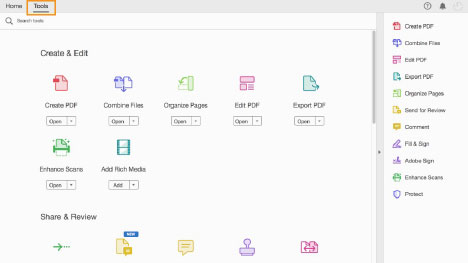Introduction
Adobe Acrobat DC is a program a part of Adobe’s Creative Cloud that gives users the ability to use PDFs in a variety of ways; these include combining different files to make new PDFs, editing and annotating PDFs, and much more. Also, as Acrobat is a part of Adobe’s Creative Cloud, files are typically interchangeable between different applications1.
Background
Initially released in 1993 to compete with other document-creating products2. Adobe Acrobat has since evolved to create PDF files and manipulate and view PDFs in several different manners.
PDF stood for Portable Document Format for those unfamiliar with PDFs and was developed by Adobe in 19923. The main purpose of a PDF is to present documents, either text or images; the main benefit of this file type is that it is easily accessible from almost any computer, and the security of the file is often very secure4.
Like many other productivity applications, when Acrobat was first introduced, the program’s potential was not yet realized. Over time, Acrobat was developed to be the Swiss Army knife for PDF files. For example, in 2015, Acrobat began to incorporate several features made possible by cloud computing5.
Process
To utilize all of the benefits of Acrobat, a user must sign in to their Creative Cloud account to download Acrobat as an executable onto their device. This assumes that a user has already purchased the program and has an active license to use Acrobat before downloading; however, currently enrolled ASU students have full access to Adobe’s Creative Cloud at no additional cost.
Furthermore, it should be mentioned that Acrobat’s file size is relatively small for what it does, as it only needs roughly 2.73 GB of storage6.
Here is what a user might see if they open Acrobat on their computer:

Note: the user interface might change based on the version and platform used.
The features of Acrobat are categorized into different sections based on what their primary purpose is. For example, in the Create & Edit tab, one would find the ability to create a PDF. Creating a PDF can be done in several ways, such as a user wanting to combine several other PDF files into one or a user creating a brand new PDF from scratch.
Again, Adobe products are known for their robust nature. With that being said, Adobe has created several different tutorials ranging from guides on how to get started with Acrobat to tutorials on doing more advanced PDFs.
Here are some examples of the tutorials that are available here7.
|
Users can create PDFs in a multitude of ways |
|
|
Users can share and edit different PDFs |
|
|
Users can learn how to attach different forms of security to their PDFs |
|
|
Users can print their PDFs |
Brand information
As Adobe puts it on their website, “Creativity is in our DNA”8. Adobe has become synonymous with media editing software, and this can be credited to their 50+ Adobe software products that enable users to bring their ideas to life. Their most known products include Photoshop, Illustrator, and Primer Pro.
Moreover, as previously mentioned, Adobe created the PDF file format in the first place, so they have set the foundations for several different areas in the computer science field.
Uses in education
At ASU, there is a reason why Creative Cloud is free to those who request it9. Adobe products are used by students daily for their classes and their projects, as the capabilities of Adobe products allow for both flexibility and creativity. Many film students may use Adobe Premiere Pro to create short films for a class, or Graphic Design students can use Photoshop to create their projects.
As for Acrobat, both staff and students can employ the program, as both are bound to encounter PDF files during their time at ASU. A professor might use Acrobat to create their course’s syllabus, or a student might have to sign and edit a PDF for a scholarship application.
References
1 Adobe PDF collaboration. (n.d). Adobe. Retrieved April 13, 2022, from
https://www.adobe.com/acrobat/hub/how-to/collaborative-document-editing
2 Adobe Acrobat development (n.d).Knowledge at Wharton. Retrieved April 13, 2022, from
3 Camelot Project (n.d).Adobe. Retrieved April 13, 2022 from
4 PDF file benefits (n.d).ABBYY. Retrieved April 13, 2022, from
https://pdf.abbyy.com/learning-center/what-is-pdf/
5 Adobe cloud technology (n.d).Info World. Retrieved April 13, 2022, from
6 Acrobat system requirements (n.d).Adobe. Retrieved April 13, 2022, from
https://helpx.adobe.com/acrobat/system-requirements.html
7 Acrobat tutorials (n.d).Adobe. Retrieved April 13, 2022, from
https://helpx.adobe.com/acrobat/user-guide.html
8 About Adobe (n.d).Adobe. Retrieved April 17, 2021, from
https://www.adobe.com/about-adobe
9 ASU UTO Creative Cloud (n.d).ASU. Retrieved April 13, 2022, from
